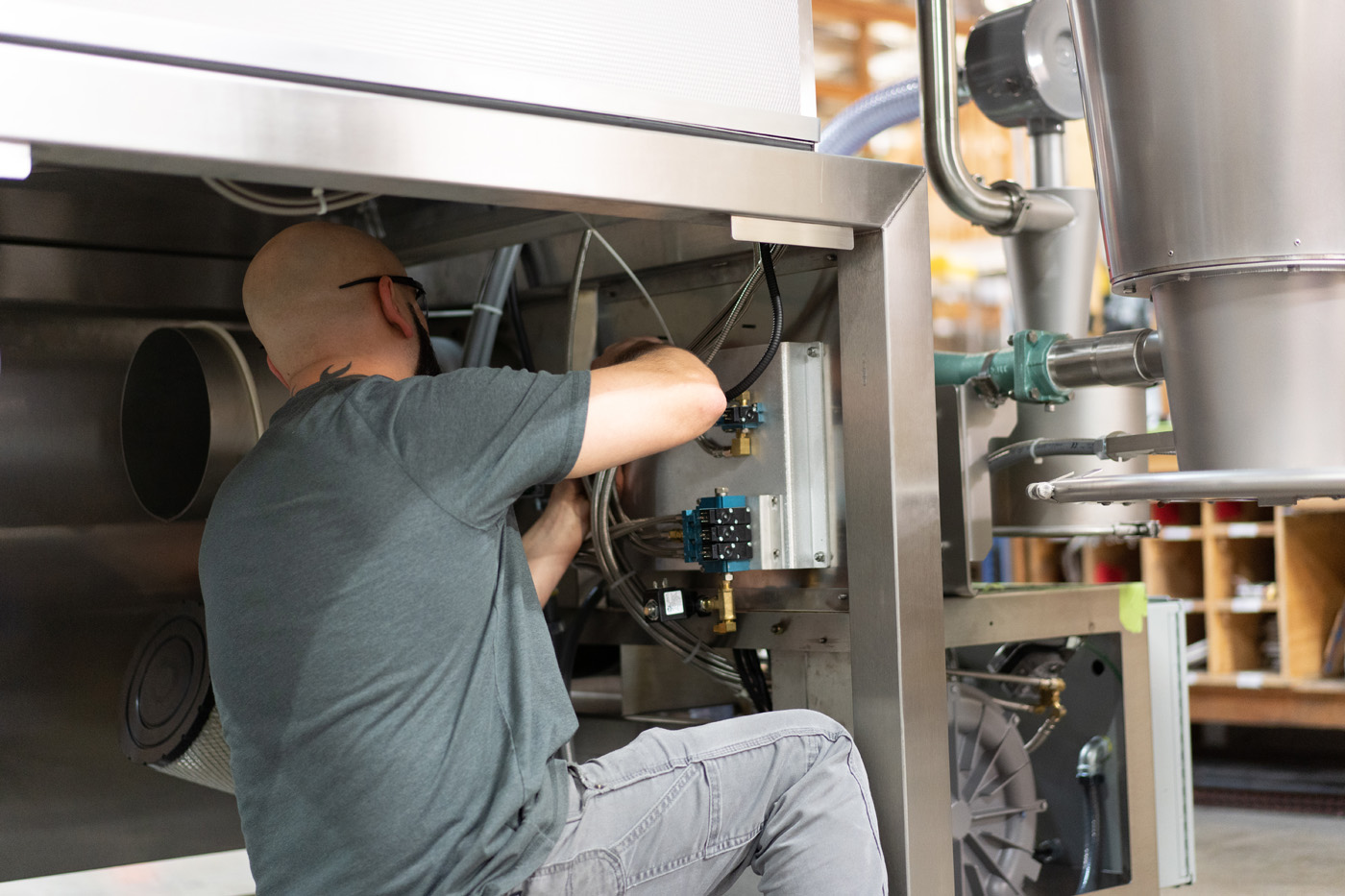
A well-maintained coffee roaster is essential for consistent flavor, safe operation, and long-term reliability. But with everything happening inside a busy roasting facility, short-term maintenance can get pushed aside until something goes wrong, which usually means downtime, wasted coffee, and costly repairs.
Whether you’re running a small roasting operation or managing high-volume production, a simple, consistent maintenance routine goes a long way. And if you roast on a Loring, you already have a system designed to reduce maintenance needs thanks to its stainless-steel construction and streamlined design. Explore Loring’s technology overview to see how the system works.
Our Loring Roaster Owner’s Manual goes into detail about maintenance, including additional suggestions for bi-monthly, semi-annual, and annual maintenance. Loring Support can also provide assistance or maintenance training to keep you on schedule.
Let’s walk through the essentials for daily, weekly, and monthly maintenance.
What Maintenance Does a Loring Coffee Roaster Need?
Before performing any maintenance, except where otherwise noted, the roaster should be completely powered off and allowed to cool down to room temperature so that all surfaces, including interior components, are safe to touch. Proper safety measures, such as Lockout/Tagout procedures, should be followed according to applicable regulatory policies.
1. Daily Roaster Maintenance
Q: What should be cleaned or checked every day?
A: Daily maintenance prevents buildup and keeps roast quality consistent.
Typical daily tasks include:
- Emptying the chaff barrel every 10 roasts or so, or when chaff reaches the “full” line
- Wiping down surfaces and control panels for hygiene
- Verifying proper ignition and burner function
2. Weekly Maintenance Tasks
Q: What should I do weekly?
A: Weekly routines help ensure safe, clean, and consistent roasting.
Areas that should be cleaned or inspected weekly include:
- Cooler tray
- Cooler ducts
- Dust collection and filters
- Chaff barrel lid and cyclone
- Chaff quench function
3. Monthly Maintenance
Q: What should be done every month?
A: These tasks keep your machine efficient and prevent long-term wear.
Depending on your roaster model, maintenance may include:
- Cleaning the cyclone spray nozzle
- Cleaning or replacing motor filters
- Cleaning behind the drum screen
- Inspecting the purge gate
Loring roasters simplify monthly maintenance because the system more efficiently prevents particulate matter in the hot and cold exhausts.
👉 Learn about Loring’s sustainability and efficiency benefits.
How Do I Clean a Commercial Coffee Roaster Safely?
1. Always Allow Cooling Time
Q: Can I clean the roaster while it’s still warm?
A: No. Let the machine cool completely before cleaning. Hot surfaces can be dangerous and may cause cleaning products to vaporize.
2. Use the Right Tools & Cleaning Agents
Avoid abrasive chemicals or metal tools that could scratch the finish or damage seals, sensors, or internal surfaces.
Loring Support can provide guidance on materials that are safe for our stainless-steel systems.
👉 Contact support: https://loring.com/contact/
3. Keep Airflow Pathways Clear
Airflow is the heart of roasting. Blocked airflow leads to uneven roasting, system malfunction, or even fire.
Clear chaff, oil residue, and particulates from:
- Air ducts
- Cooling tray screens
- Cyclone and chaff barrel
- Dust collectors and filters
- Exhaust pathways
The cleaner the airflow, the safer and more consistent your roasts.
How Do I Keep My Roasting Operation Safe?
1. Train Every Team Member
Q: Do all roastery staff need safety training?
A: Absolutely. Everyone involved in roasting, from production assistants to lead roasters, should understand system controls, emergency procedures, and proper handling.
Loring Support can provide guidance on what to do in the event of emergency or fire.
👉 Contact support: https://loring.com/contact/
2. Monitor Gas, Ventilation, and Electrical Systems
Take notice of and remedy any damage, leaks, loose connections, or poor performance.
3. Document Your Maintenance Routine
Create a simple log for:
- Completed maintenance tasks
- Replaced parts
- Safety checks
Good documentation keeps your team accountable, ensures consistency, and helps diagnose issues quickly.
A suggested maintenance schedule is available in the Loring Roaster Owner’s Manual.
Why Loring Makes Roaster Maintenance Easier
Loring roasters are engineered to reduce the time and effort required for maintenance. The benefits include:
✔ No external afterburner
Fewer parts, fewer problems.
✔ Stainless-steel construction
Hygienic, durable, and minimizes residue.
✔ Easy access to maintenance areas
Streamlined parts and no specialty tools required.
✔ World-class customer service, world-wide
Our experienced and specialized Support team are here to help.
✔ Stronger uptime & fewer repairs
A more reliable machine means more production hours.
Explore how Loring’s technology supports smoother operations:
👉 https://loring.com/roasters/
Conclusion
A well-maintained roasting machine is essential for safety, optimal flavor, and the highest standard of efficiency. Daily, weekly, and monthly routines don’t need to be complicated, and with a Loring roaster, they’re significantly simpler.
Less downtime. Cleaner roasts. Fewer headaches.
If you’re looking for roasting equipment that’s easier to maintain, safer to operate, and more efficient over the long term, Loring’s technology is built for exactly that.
👉 Want to learn more? Contact our team or browse our roaster lineup.